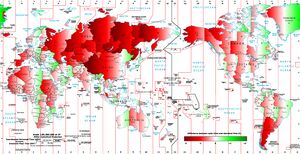Difference between revisions of "Circadian management"
| Line 4: | Line 4: | ||
[[File:Circadian human.png|thumb|Typical circadian timings of physiological processes]] | [[File:Circadian human.png|thumb|Typical circadian timings of physiological processes]] | ||
The circadian rhythm regulates a range of physiological processes that controls sleep-wake cycles. These rhythms are synchronized to [[Wikipedia:Local mean time|local solar time]] (rather than clock time) when they are stabilised. In some regions, local clock time can differ substantially from the solar time, and additional consideration is required to correctly plan circadian management measures. | The circadian rhythm regulates a range of physiological processes that controls sleep-wake cycles. These rhythms are synchronized to [[Wikipedia:Local mean time|local solar time]] (rather than clock time) when they are stabilised. In some regions, local clock time can differ substantially from the solar time, and additional consideration is required to correctly plan circadian management measures. | ||
| − | [[File:Solar time map.jpg|thumb|Those living in red regions should subtract hours from their clock time to get the solar time, and those living in green regions should add hours. The number of hours is to add can be seen according to the colour legend below. | + | [[File:Solar time map.jpg|thumb|Those living in red regions should subtract hours from their clock time to get the solar time, and those living in green regions should add hours. The number of hours is to add can be seen according to the colour legend below.]] |
{| class="wikitable" | {| class="wikitable" | ||
|+Typical circadian markers | |+Typical circadian markers | ||
Revision as of 06:36, 21 December 2020
Circadian management includes various ways to optimise one's circadian rhythm with respect to one's sleep schedule. The stability as well as the alignment of your circadian rhythm is critical to maintaining the quality of your sleep. However, depending on the timings of your sleeps and your scheduling restraints, you may or may not be able to sleep at optimal hours. To this end, it is possible to mitigate the effects of suboptimal sleep timings through shifting the circadian rhythm itself.
Circadian structure
The circadian rhythm regulates a range of physiological processes that controls sleep-wake cycles. These rhythms are synchronized to local solar time (rather than clock time) when they are stabilised. In some regions, local clock time can differ substantially from the solar time, and additional consideration is required to correctly plan circadian management measures.
| Local Solar Time | Marker | Note |
|---|---|---|
| 21:00-00:00 | SWS peak | |
| 01:00-03:00 | Lowest alertness | Sleep is most favoured in this time |
| 04:00-06:00 | Min. body tempeturature | This may or may not be the time with the strongest subjective feeling of coldness |
| 06:00-09:00 | REM peak | |
| 09:00-11:00 | Highest alertness | |
| 11:00-17:00 | Daytime nap zone | This corresponds to the circadian dip in the early afternoon. |
| 17:00-19:00 | Max. body temperature |

